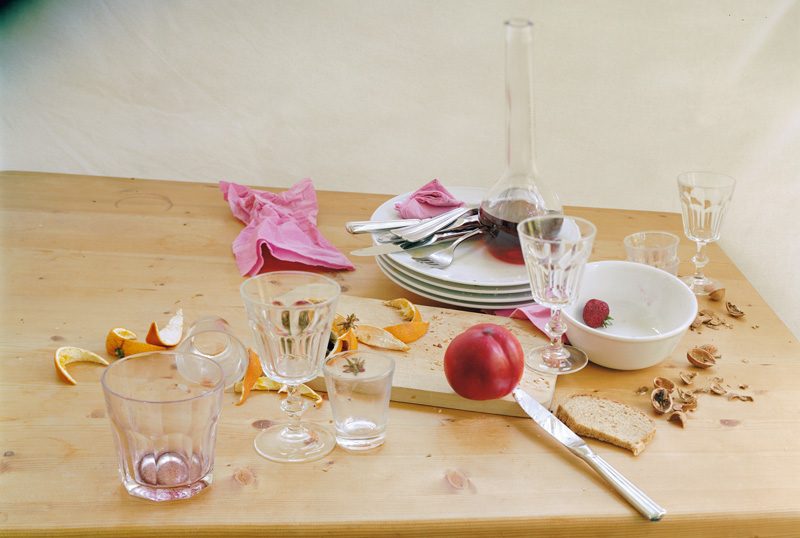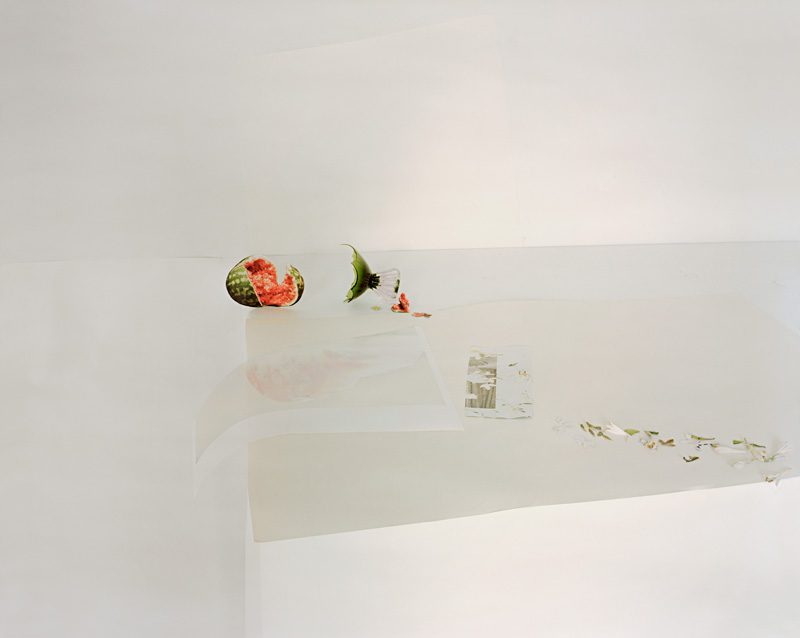Carleton University Art Gallery, Ottawa
16 September 2013 to 19 January 2014
By Robert Evans
For over a decade, Winnipeg-born photographer Laura Letinsky has pursued still-life photography as a means to explore social structures and the world around us. The works in Laura Letinsky: Still Life Photographs 1997–2012 at the Carleton University Art Gallery (CUAG) are drawn from five series and range from early compositions that owe obvious debts to the traditional still-life genre, perfected in seventeenth-century Dutch painting, to more recent images that challenge the viewer’s understanding of picture space and the nature of photographic representation. Although challenges to longstanding traditions in visual art are not in themselves extraordinary pursuits – what relevant contemporary art doesn’t “challenge” or “subvert” some practice or subject? – there is an uneasy beauty in Letinsky’s still lifes that engages the viewer far beyond their critical function.
The photographs range from more or less traditional tabletop still-life settings, kitchen scenes, and fragments of domesticity, in some of the older works, to an explicit concern with the circulation and making of images, in the more recent series, Ill Form and Void Full. However, this change in Letinsky’s work is not the narrative spine for the installation at CUAG. Such an arrangement would have created a predictable teleological experience: early tentative steps, mid-course experiments, and later resolved work. Instead, the photographs are installed by tonality, by size, and by criteria other than chronological sequence, creating a sense that we are looking at a unified oeuvre in which we discover relationships between older and newer works despite differences in content and approach.
Untitled #14 (Hardly More Than Ever) (2001), the most traditional still life in the exhibition, would be instantly recognizable to a seventeenth-century painter. Stacked plates, empty glasses, crumpled napkins, bits of fruit rind, an apple, a flask partially filled with red wine, and a wood table, among other elements, are highly legible and appear in a stable picture space. But instead of alluding to emblems and symbols, as would a Dutch Baroque still life, the photograph is an index of domestic and consuming bodies: the meal and the leftovers are signs of preparation and consumption.
In a way, Letinsky’s more recent still lifes are also about preparation and consumption: the making and consuming of photographs. Evident in even the earliest photographs is Letinsky’s concern with making a picture. For example, in Untitled #114 (Hardly More Than Ever) (2003), she places small objects in the foreground and a large object in the background, including only an awkward corner of the table upon which they are placed. The combination of a background object that is larger than the foreground objects and an unstable (almost untenable) table challenges, like a minimalist Escher drawing, our perception of pictorial space.
The older photographs in the exhibition are constructed in the traditional manner of analogue photography: materials placed in front of the lens are stage-managed to create the desired effect. The more recent photographs are also constructed, but instead of real-world props, Letinsky has incorporated mass-media print images, her own prints, and paper-based objects to create tableaux that not only are doubly removed from their original referent, but also consume other photographs. Untitled #18 (Ill Form and Void Full) (2011) is a combination of cut-out photographs from other sources held in place by transparent tape, real-world paper objects such as a doily, and three-dimensional objects (a transparent plastic straw and a drink-cup cover). The “real” three–dimensional objects barely register in the photograph and are mere suggestions of the indexical function of photography, whereas the photographs and paper objects in the frame dominate the scene.
Describing the contents or elements that Letinsky combined to create the later pictures in the exhibition does not convey the beauty, the tenuousness, and the ambiguity of the images. It may be a rewarding game for some to untangle the various components and identify what is real and what is a (real) picture. Ultimately, however, this is not a productive pursuit. How would this knowledge enrich our understanding of the image except as an acknowledgment of Letinksy’s cleverness? And surely these photographs are much more than clever. These are contemplative pictures with an overabundance of semantic availability. In the end, their power is not as critiques of making and consumption, but as thoughtful pieces that have their beginnings in those critical discussions.
Robert Evans is an independent scholar and visual arts and museum consultant. He holds a PhD from Carleton University, and his current research interest is digital cultural heritage.


